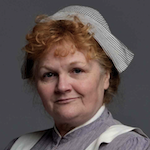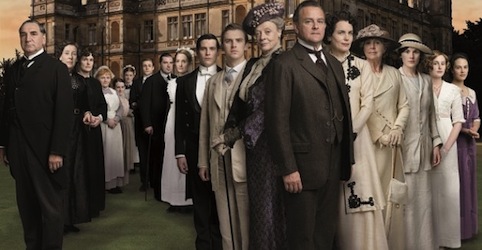While class separates the women upstairs from the women downstairs at Downton Abbey, and this class difference intersects with gender in various ways, they ultimately do share a common gender. Such is the uniting potential of shared social and political disadvantage that often it breaks through the other barriers between people. The first two seasons of Downton Abbey span the 1910s and it should be interesting to see how the 1920s affect the women of Downton Abbey in the third season.
 Mrs. Hughes (Phyllis Logan): Mrs. Hughes more than any other character is a steadying force downstairs. This means she is often involved in the plots of others. The main time she is the center of a plot is when she briefly rekindles a relationship with a man from her past and has to decide if she will pick work or love, a choice she had faced years earlier. This raises the classic battle of work and home that only recently has faded as a choice to be made. What this plot really seems to emphasize is that, with the exception of Mr. Bates and Anna, none of those in the downstairs seem to have family lives. Their entire persons are committed to the job and when they aren’t, it tends to be scandal. This makes it as much a class issue as a gender one, though outside the show’s context it certainly does have that gender implication.
Mrs. Hughes (Phyllis Logan): Mrs. Hughes more than any other character is a steadying force downstairs. This means she is often involved in the plots of others. The main time she is the center of a plot is when she briefly rekindles a relationship with a man from her past and has to decide if she will pick work or love, a choice she had faced years earlier. This raises the classic battle of work and home that only recently has faded as a choice to be made. What this plot really seems to emphasize is that, with the exception of Mr. Bates and Anna, none of those in the downstairs seem to have family lives. Their entire persons are committed to the job and when they aren’t, it tends to be scandal. This makes it as much a class issue as a gender one, though outside the show’s context it certainly does have that gender implication.
 Mrs. O’Brien (Siobhan Finneran): It’s a little hard to talk much about Mrs. O’Brien as she is one of the more one-dimensional characters on the show. Along with Thomas, she is an almost purely malevolent force of convenient dramatic tension. She is given a few moments of slight redemption that Thomas has never earned. It is unfortunate that Thomas, the only gay character among the recurring roles, is the one put into this nasty position as the epitome of evil.
Mrs. O’Brien (Siobhan Finneran): It’s a little hard to talk much about Mrs. O’Brien as she is one of the more one-dimensional characters on the show. Along with Thomas, she is an almost purely malevolent force of convenient dramatic tension. She is given a few moments of slight redemption that Thomas has never earned. It is unfortunate that Thomas, the only gay character among the recurring roles, is the one put into this nasty position as the epitome of evil.
Anna (Joanne Froggatt) and Vera Bates (Maria Doyle Kennedy): Vera Bates and Anna are  linked through Mr. Bates to provide insight into the traumatic nature of restrictive divorce rules. Though not feeling sympathy for Vera, Anna does point out the ridiculous notion that infidelity by a woman is grounds for a man to divorce but infidelity by a man is not grounds for a woman. In this case, not being able to unilaterally divorce gives Vera the chance to extort her husband and cause him misery. Typically, the concern would be forcing women to stay with men who physically abuse them. Of course, there’s a sense of unease in the story basically making you support the potential murder of a woman by making her quite unreasonable.
linked through Mr. Bates to provide insight into the traumatic nature of restrictive divorce rules. Though not feeling sympathy for Vera, Anna does point out the ridiculous notion that infidelity by a woman is grounds for a man to divorce but infidelity by a man is not grounds for a woman. In this case, not being able to unilaterally divorce gives Vera the chance to extort her husband and cause him misery. Typically, the concern would be forcing women to stay with men who physically abuse them. Of course, there’s a sense of unease in the story basically making you support the potential murder of a woman by making her quite unreasonable.
 Daisy (Sophie McShera): Daisy is lovable like a child, yet also a bit hard to take seriously, like a child. She is just so innocent and naive that it feels a bit degrading as a portrait of a woman, watching her pushed around like she is. Still, her main plot is a rich one for gender implications. From the outset, William is smitten with her, an unreciprocated feeling. Situations increasingly pressure her to do the “nice” thing and act like she returns the sentiment, his feelings being clearly favored to hers by those around her. While this situation gets more complex than would be typical, the pressure for women to be obliging plays out in many ways in the real world.
Daisy (Sophie McShera): Daisy is lovable like a child, yet also a bit hard to take seriously, like a child. She is just so innocent and naive that it feels a bit degrading as a portrait of a woman, watching her pushed around like she is. Still, her main plot is a rich one for gender implications. From the outset, William is smitten with her, an unreciprocated feeling. Situations increasingly pressure her to do the “nice” thing and act like she returns the sentiment, his feelings being clearly favored to hers by those around her. While this situation gets more complex than would be typical, the pressure for women to be obliging plays out in many ways in the real world.
 Gwen (Rose Leslie): There’s a weird pressure within the downstairs to treat their positions with the highest of respect such that even suggesting one would rather do something else is seen as improper or even uppity. This hits Ethel a little with her dreams of stardom but it is Gwen who has realistic plans to move beyond service, training as a secretary and typist. One of the most beautiful aspects of her story is the great effort Sybil puts in to assist her in this pursuit. Contrasting against the competitiveness of Mary and Edith, this is an example of the way feminine cooperation can lead to great things.
Gwen (Rose Leslie): There’s a weird pressure within the downstairs to treat their positions with the highest of respect such that even suggesting one would rather do something else is seen as improper or even uppity. This hits Ethel a little with her dreams of stardom but it is Gwen who has realistic plans to move beyond service, training as a secretary and typist. One of the most beautiful aspects of her story is the great effort Sybil puts in to assist her in this pursuit. Contrasting against the competitiveness of Mary and Edith, this is an example of the way feminine cooperation can lead to great things.
Ethel (Amy Nuttall) and Jane (Clare Calbraith): The stories of Ethel and Jane are linked by the stigma of being single  mothers. Jane is respectful enough, having lost her husband in the war, but even so, she’s in an odd spot. A system based around a male breadwinner supporting a woman to raise the children doesn’t work if the man is gone, but society at that point didn’t provide much infrastructure for a woman to effectively fill both roles.
mothers. Jane is respectful enough, having lost her husband in the war, but even so, she’s in an odd spot. A system based around a male breadwinner supporting a woman to raise the children doesn’t work if the man is gone, but society at that point didn’t provide much infrastructure for a woman to effectively fill both roles.
Ethel’s route to single motherhood is much more scandalous, the result of premarital sex. Ethel made her lusting evident beforehand, a clear violation of the sexual mores of the time, especially for women. Once she has the child, the mere fact of her indiscretion is used against her to prevent much of a livelihood without the charity of others. Even the child’s grandparents aren’t able to get over the scandal of the child’s origin to accept Ethel. Banishing her is more important to them than making sure the child has a decent life. Any look at the debate about social issues reveals that out of wedlock births remains a great boogeyman in conservative claims of societal collapse.
 Mrs. Patmore (Lesley Nicol): While no strong gender themes jump out related to Mrs. Patmore, her rather stern interaction with Daisy certainly hints at some young-old tension. Indeed, one of Mrs. Patmore’s more notable plot points is fading eye-sight that would render her useless as a cook. Meanwhile, we see Daisy grow incredibly in her skills over the course of the show. This sort of tension is very classical, perhaps most notable in Snow White, with the fear of becoming obsolete due to the young, especially in terms of beauty and sensuality, leads to conflict.
Mrs. Patmore (Lesley Nicol): While no strong gender themes jump out related to Mrs. Patmore, her rather stern interaction with Daisy certainly hints at some young-old tension. Indeed, one of Mrs. Patmore’s more notable plot points is fading eye-sight that would render her useless as a cook. Meanwhile, we see Daisy grow incredibly in her skills over the course of the show. This sort of tension is very classical, perhaps most notable in Snow White, with the fear of becoming obsolete due to the young, especially in terms of beauty and sensuality, leads to conflict.
– Erik Bondurant




